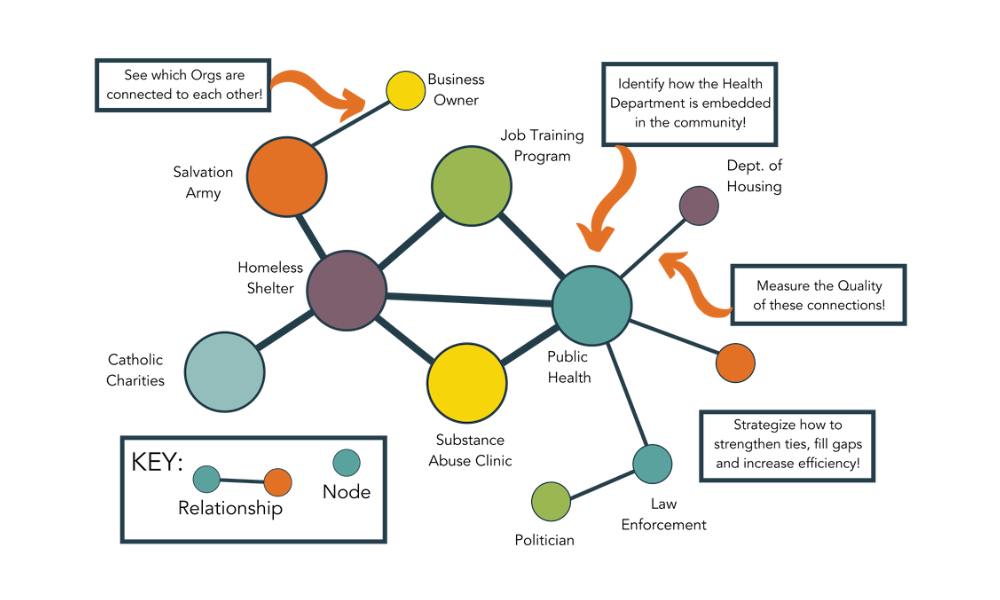As professionals working in community partnership roles, we often face resistance when attempting to introduce systems change. This resistance may come from various sources and forms: lack of understanding, fear of change, power dynamics, among others. Yet, network science provides us with unique perspectives and strategies to overcome these hurdles.
Here are seven network science-informed tips to help navigate resistance and foster successful systems change initiatives.
Table of Contents
1. Understand the Existing Network Structure

- Visualize your network: Use tools like PARTNER CPRM to create a visual representation of your current network.
- Analyze relationships: Identify the nature, strength, and interdependencies of relationships within your network.
- Assess power dynamics: Use centrality measures to understand who holds power in the network and how it’s distributed.
2. Identify Key Influencers and Leverage Their Influence
Within any network, some individuals or organizations wield more influence than others. Use network measures like centrality to identify these key influencers. By winning their support early, you can leverage their influence to advocate for the change initiative, easing the path for wider acceptance.
- Identify influencers: Use network measures like centrality to pinpoint these individuals or organizations.
- Engage influencers: Involve them in early discussions, take their feedback, and address their concerns.
- Leverage influencers: Encourage them to advocate for the initiative within their spheres of influence.

Get our monthly newsletter with resources for cross-sector collaboration, VNL recommended reading, and upcoming opportunities for engaged in the “network way of working.”
3. Encourage Cross-Sector Collaboration

- Identify potential collaborators: Look for partners with diverse perspectives and resources. Groups with different goals or background will bring more new ideas and opportunities to the broader group to consider.
- Build partnerships: Initiate conversations, identify shared goals, and establish partnership agreements. Take time to build trust through regular communication and interactions.
- Maintain collaboration: Regularly review partnerships, address any emerging issues, and celebrate collaborative achievements.
4. Communicate Clearly and Regularly
Effective communication is crucial to mitigating resistance. Use your network map to identify the most efficient channels for communication. Then, ensure your message about the necessity and benefits of the change initiative is clear, concise, and tailored to your audience. Regularly update your partners about the progress and challenges of the change initiative.
- Plan your communication: Identify the most efficient channels for communication based on your network map.
- Craft your message: Ensure your message is clear, concise, and tailored to your audience.
- Maintain communication: Regularly update your partners about the progress and challenges of the initiative.
5. Build Trust Through Transparency

- Share your plans and strategy: Disclose your goals, strategy, and potential challenges upfront. Don’t keep any part of your agenda; lay your cards on the table from the start.
- Seek feedback: Regularly solicit and openly address feedback instead of saying something like, ‘we’ll get back to you later.’
- Report progress and setbacks: Regularly update all partners about the progress, learning, and adjustments.
6. Foster a Culture of Learning and Adaptability
Change is a process, not a one-time event. Foster a culture that values learning, feedback, and adaptation. Celebrate small wins, learn from setbacks, and use them to refine your change initiative. By making learning and adaptability part of your network’s culture, you make it more resilient to future change.
- Promote open dialogue: Encourage partners to share their experiences, concerns, and ideas.
- Celebrate small wins and learn from setbacks: Use both success and failure as learning opportunities.
- Refine strategies based on learning: Regularly review and adjust your approach based on the feedback and results.
7. Use Data to Show the Impact

- Collect relevant data: Track data points that directly demonstrate your initiative’s impact.
- Analyze the data: Use appropriate statistical methods to reveal patterns, trends, and impacts.
- Communicate findings: Share your findings with your network and beyond, using visuals and narratives to highlight your initiative’s success.

Get our monthly newsletter with resources for cross-sector collaboration, VNL recommended reading, and upcoming opportunities for engaged in the “network way of working.”
Overcoming Resistance to Systems Change: 7 Tips
Overcoming resistance to systems change requires a strategic, evidence-based approach informed by network science principles. By understanding your network’s structure, leveraging key influencers, fostering collaboration, communicating effectively, building trust, fostering a learning culture, and demonstrating impact, you can navigate resistance and set the stage for meaningful, sustained change. Remember, every network is unique, so these strategies should be adapted to your specific context for the best results.
Additional Reading and Resources
Here are some additional articles, websites, and resources with information about PARTNER CPRM and strategic collaborative management in public health practice.
Learn More: Request a Demo!

Our experts will guide you through its tailored features, ensuring you harness the full potential of your collaborative network. Your journey towards a more strategic, connected community network starts here.






